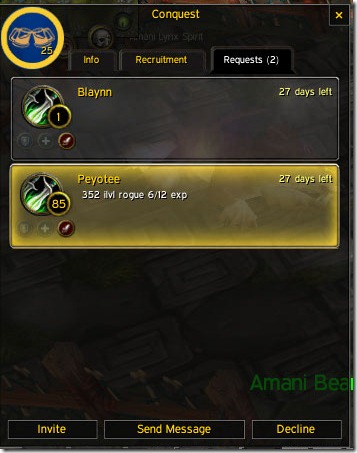It took the guild 3 years, but it was bound to happen sooner or later.
I just lost over 14 players from my raiding roster.
It started out as a simple personnel disagreement. There was a quiet debate raging within me for some time. On the one hand, I understand the strains of progression raiding and the impact it can make to a roster especially on the drive to having flawless raid nights. We all want a mistake-free raid group with players who can ace every obstacle thrown at them.
But does that mean putting up with personalities you don’t agree with all the time? The game was getting to the point where it was no longer fun for me.
Actually, scratch that. The game itself was fine. The managing social dynamics and personalities aspect made the game not fun. All I ever wanted to do was kill internet dragons, with friends or otherwise. One of the policies I even had in place for players was that they weren’t required to be friends with everyone. They didn’t have to go to the bar with them or anything. Over time, however, I began to wonder if that was a standard I could hold to myself. I realized that I had a very difficult time doing that because of all the added responsibilities and inter-personal problems that I had to deal with as part of my rank. As a player, in contrast to being an officer or guild leader, the only person you really need to be cool with is the GM. If the GM isn’t cool with you, then there’s no point in being there. This goes hand in hand with the chemistry clause – The right for applicants to be rejected because they don’t “fit” with the guild.
Competence and likeability are not mutually exclusive. The players I’m looking for have both. But it seems that the higher the skill level you go, the more disrespectful people become. Why? I can’t help but wonder if it’s because they believe their skills can give them an excuse to act however they want and get away with it. I don’t want to deal with that. If a player is skilled but not likeable, I’ll end up showing them the door. If a player is likeable but not skilled, eventually a newer player will work their way in and take their spot. That’s just how it is going to be.
Respect the chain of command
For any budding officers out there, this is the most important rule. If you bring up an idea, any GM worth their salt will at least hear you out and weigh all the negatives and positives associated with it. It’s up to you to sell your perspective. But once the decision from the top is made, that’s that. There is no higher authority to appeal to. You’ll have a hard time finding a GM who says otherwise. Do not try to circumvent it even if you know every fibre of your being says it is the right or wrong thing to do. The only thing you can do is look inside yourself and decide if it’s worth leaving over. That choice is absolutely yours to exercise. There’s no contract obligations that force you to stay in a guild.
In this particular case, cliques were cliques. When it comes to social groups like this, nothing’s going to stop people from playing with who they want. Trying to would just cause a social group to leave and create their own guild. This was a scenario I actually had in my mind as a realistic possibility. I don’t take kindly to ultimatums or threats of leaving at all. Given the option between killing internet dragons with people I’ve shared beers and had a good time with versus players who are willing to throw other people under a bus at a whim, I’d rather shoot for the former. I absolutely love raiding but not at the cost of my own mental health. Leading a guild isn’t easy at all when it comes to executive level decision making.
I still maintain that is perfectly possible to raid in a progressive raiding environment with people who you enjoy playing with. I see it in other guilds all the time. It’s my ongoing goal to reach that state, current drama aside. The only thing I can do is look forward and exercise my recruiting skills. And what an opportunity!
The thing about hindsight is that it always occurs after the events. I wish I had gone on offense sooner and made earlier changes. I don’t know if that would have offset the events, but it means I would have been forced to start the rebuild earlier. You always think and second guess to yourself wondering if that was the right thing to do. Or if there was another alternative solution or another way. I can’t answer that because I don’t know. I felt I offered enough of a compromise by allowing a player to stick around in the guild and idle on our Mumble servers even if they weren’t in our raid team any no longer. But that’s not enough.
Regardless, I’m sure they’ll be fine. I know for a fact we’ll be fine. 9 out of 10 rebuild guilds don’t actually make it and I have zero intention of being a statistic.
I also may have made up said previous statistic.
My options
- Do 10 mans
- Look for another guild
- Quit the game
- Rebuild us back to even strength
10 mans are okay. I could go look for another guild. I could just retire from the game and step down from blogging and writing on WoW Insider.
Or I can pick my ass up off the floor, dust myself off and get back to work. I challenge you to find a GM more determined than myself. Am I saddened? Yeah, a little. Do I feel that I can recover? Oh, you bet I will. This is a great opportunity!
That being said, Conquest is open for business. Firelands 25 man raiding only and we’re presently 6/7. We’re looking for all players in any position. I think we’re stacked on Resto Shamans though. I have almost no melee DPS remaining so I’ll be entertaining Rogues, Warriors, DKs, Enhancement Shamans. Hunters, I have many of. But at this point I just need bodies. I’m interested in any caster classes. I’m also looking for hybrid specced tanks who can double as DPS (a main tank and an off tank position).
If you have any questions or want to discuss a few things beforehand, feel free to get in touch with me or Lodur anytime.



